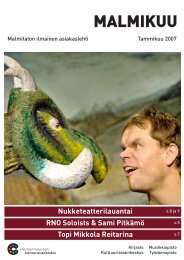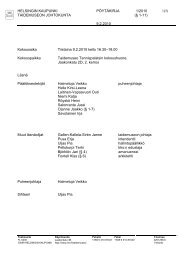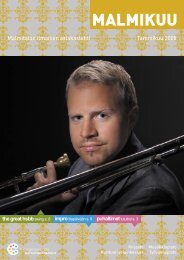Toimintakertomus | Verksamhetsberättelse | Annual Report
Toimintakertomus | Verksamhetsberättelse | Annual Report
Toimintakertomus | Verksamhetsberättelse | Annual Report
You also want an ePaper? Increase the reach of your titles
YUMPU automatically turns print PDFs into web optimized ePapers that Google loves.
OTHER CULTURAL OFFICE PREMISES<br />
Among exhibitions, hits with the public were Eric<br />
Langert’s zoo from Sweden and an exhibition of early<br />
had eight cultural programmes of the Urban II programme<br />
running under its authority. These included neighbourhood<br />
Grants awarded, 2002<br />
International Cultural Centre Caisa<br />
Caisa is an international cultural centre in the heart of<br />
Helsinki. It supports the city’s multicultural and tolerant<br />
development by promoting interaction between people<br />
from different countries and by supporting the independent<br />
cultural activities of ethnic minorities.<br />
Among the major events during the year were the<br />
Helsinki Day summer festival in Kaisaniemi Park, the<br />
Night of the Arts, Caisa’s Fair, and the Christmas<br />
bazaar. On International Women’s Day a cultural evening<br />
was held which was very popular. An adult students’ event<br />
for immigrants attracted about a thousand visitors. Caisa’s<br />
multicultural fairs also spread to Stoa and Vuosaari House.<br />
Caisa’s premises were also a venue for art exhibitions,<br />
culture evenings, theme days, internationalism<br />
education courses, seminars and activities for children.<br />
The student advisory centre for immigrants increased<br />
its popularity. A multicultural network brought<br />
representatives of various agencies, projects and organisations<br />
to Caisa each month.<br />
The Open Learning Centre project with ESR financing,<br />
which opened in 2001, continued during the year. The<br />
project’s main thrust is on developing networking and on<br />
building an electronic databank for multicultural work.<br />
Working methods and models for promoting immigrants’<br />
reorientation and employment were developed in<br />
partnership with other city agencies, state institutions and<br />
various organisations. Uusimaa Regional Council decided<br />
to locate a fixed-term, multicultural information centre in<br />
Caisa starting from the beginning of 2003.<br />
Annantalo Arts Centre<br />
The Annantalo Arts Centre is a cultural development centre<br />
for children and young people, the function of which is<br />
to provide the children and young people of Helsinki with<br />
varied opportunities to make and experience art.<br />
The Annantalo Arts Centre’s 15 years in operation were<br />
celebrated at the Children’s Night of the Arts on 29 August<br />
2002. During the evening, workshops, concerts, theatre<br />
performances and openings of four art exhibitions were<br />
attended by about 4,500 children and their parents.<br />
The spring themes for art education were flowers and<br />
growing, while the autumn themes were the Kalevala and<br />
Finnish mythology. Literary art was re-included in the<br />
workshop programme. In connection with reading and<br />
literature, the traditional Fairytale Day was held along<br />
with Favourite Book Day Eve and a children’s own literature<br />
seminar.<br />
illustrations by Rudolf Koivu.<br />
As a result of cultural courses and continuation projects<br />
from Helsinki’s year as City of Culture, cooperation with<br />
art institutions in the Helsinki Metropolitan Area and<br />
other cultural operators continued to gain in strength.<br />
Cultural courses and sessions of Getting to Know Art<br />
were held in partnership with Helsinki Education Department<br />
and art institutions. Among the results of the Getting<br />
to Know Art project was the Messages from the<br />
Varangians spatial art work, which was completed by<br />
class 7A from Vartiokylä at Puotila metro station together<br />
with artist Veikko Björk.<br />
The international children’s theatre event Bravo! was<br />
held in March with the Finnish ASSITEJ centre and<br />
cultural operators in the Helsinki Metropolitan Area. There<br />
were six visiting performances, staged 41 times at houses<br />
of culture in the Helsinki Metropolitan Area.<br />
Noteworthy examples from other programme and public<br />
work was Leffakansio, a series of children’s films<br />
arranged for the first time. Historical city tours were<br />
attended by 250 pupils from 44 school classes. Annantalo<br />
Arts Centre also took part in arranging the Shine! festival<br />
and the Sunday Arena at Jugendsali Hall. Theatre and<br />
dance projects were arranged for comprehensive school upper<br />
stage pupils in connection with international visits. A<br />
joint elementary teaching experiment by drama studios<br />
was started together with the Youth Office.<br />
Urban Culture Unit<br />
The Urban Culture Unit supports local, grassroots cultural<br />
work and regional networking. The work is done together<br />
with local residents, organisations, companies and other<br />
local parties.<br />
In the course of the year, the Urban Culture Unit<br />
supported sixty residents’ projects and events. The Stadi<br />
Folk Festival, arranged by the Urban Culture Unit and the<br />
networks arranging district festivals, embraced more than<br />
42 events, which attracted roughly 90,000 visitors.<br />
With the support of the Healthy and Safe City Board, the<br />
Urban Culture Unit launched six interactive community art<br />
and process art projects in different city districts with the<br />
participation of artists, artists’ organisations and local<br />
residents. Projects included Taivaskallio People in Käpylä,<br />
community art projects in Vuosaari, recycled art projects in<br />
Myllypuro, a community theatre in Pikku-Huopalahti, a<br />
poverty art project in Alppila, and a project getting to grips<br />
with disruptive youths in Käpylä.<br />
In the eastern region of the city, the Urban Culture Unit<br />
artists and IT applications at the office established in a shopping<br />
centre in Kontula.<br />
Cultural and<br />
Library Committee<br />
The committee members<br />
The committee was chaired by Riitta Suominen (National<br />
Coalition Party) and her deputy was Tero Tuomisto (Social<br />
Democratic Party). The other members were Jussi<br />
Chydenius (Greens), Reiska Laine (Left Alliance, as of 13<br />
March 2002 Greens), Päivi Lipponen (Social Democratic<br />
Party), Leena Löyttyniemi (National Coalition Party), as of<br />
10 October 2002 Tanja Remes (Greens), until 9 October<br />
2002 Kati-Riikka Tuurala (Greens), Lauri Törhönen (National<br />
Coalition Party) and Henrika Zilliacus-Tikkanen (Swedish<br />
People’s Party). The deputy members serving were Helena<br />
Lauriala (National Coalition Party), Mikko<br />
Hakkarainen (Social Democratic Party), Timo Nurmiluoto<br />
(National Coalition Party), Olli Vasa (National Coalition<br />
Party), Paula Koskimäki (Social Democratic Party), Jaime<br />
Potenze (Greens), until 9 October 2002 Tanja Remes<br />
(Greens) and as of 10 October 2002 Hanna Fontana<br />
(Greens), Riitta Kaukonen (Left Alliance) and Sture Gadd<br />
(Swedish People’s Party). The secretary of the committee<br />
was Marja-Elina Tyrväinen. The representative of Helsinki<br />
City Board was Minerva Krohn. The Cultural and Library<br />
Committee convened on 13 occasions and passed 198<br />
resolutions.<br />
Grants<br />
The committee’s prime function is to support the field of<br />
culture and art in Helsinki.<br />
In the spring the committee confirmed the following<br />
areas of emphasis for the grants policy: multiculturalism,<br />
international cultural exchange, support for children’s and<br />
young people’s art education and for artists’ working<br />
facilities, development of production support, and support<br />
for the development of Swedish-speaking minority culture<br />
and regional cultural work.<br />
The amount spent on assisting art institutions and artists<br />
in 2002 was 20,262,884 euros. Most of the grants awarded<br />
by the committee took the form of operating grants to art<br />
institutions: schools and colleges of art, professional theatres,<br />
museums, and cultural and art organisations in general.<br />
The committee paid out the rest in the form of discretionary<br />
Euro<br />
Operating grants to cultural institutions 18 957 579<br />
Production grants (incl.Festadi, Koneisto,<br />
Forces of Light) 307 970<br />
Project grants 41 638<br />
Art education projects 84 500<br />
Grants for international visits 198 621<br />
Art grants 84 330<br />
Cultural communities 93 350<br />
Culture Award 8 000<br />
Continuation projects for the Year of Culture 378 423<br />
Grants to orchestras 24 380<br />
Premises grants to communities of artists 84 093<br />
Total grants 20 262 884<br />
grants such as art grants and assistance for productions.<br />
Grants to artists and the Culture Award<br />
in 2002<br />
It was decided to target art grants in the future on a few<br />
fields of art each year, determined separately. In 2002 art<br />
grants were awarded to representatives of modern dance,<br />
new media art and light music. The Culture Award for<br />
2002 was awarded to dancer-choreographer Tero Saarinen<br />
for his significant work on promoting Finnish modern<br />
dance in Finland and abroad.<br />
Study trips<br />
The Cultural and Library Committee made a sturdy trip in<br />
February to the Netherlands, where it visited local art institutions<br />
and learned about the cultural policy.<br />
The core areas of cultural activity<br />
The Cultural and Library Committee confirmed the core<br />
areas of cultural activity as promoting professional art and<br />
supporting children and young people’s art education, regional<br />
cultural work and multiculturalism.<br />
In effecting savings, administrative divisions have been<br />
urged to concentrate on their core competencies and to<br />
make savings of four per cent on their expenses on<br />
premises. It was decided to effect the Cultural Office’s<br />
savings for 2003 by giving up the premises at the White<br />
Hall and Kurkimäki Community Centre. Savings were<br />
mostly effected in grants to art institutions in such a way<br />
that art education for children and young people remained<br />
on a par with the previous year’s level and cuts of 5 - 6%<br />
were made in assistance to other art institutions.<br />
30 ENGLISH SUMMARY 2002 ENGLISH SUMMARY 2002<br />
31

















